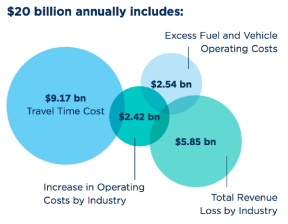Growth or Gridlock?
This morning, the Partnership for New York City publicly released its long-awaited study, Growth or Gridlock: The Economic Case for Traffic Relief and Transit Improvements for a Greater New York. London’s congestion charging initiative was kick-started, in large part, by a similar report published by London First, that city’s version of the Partnership. From today’s report:
Looking at just a limited set of costs and industry sectors and using very conservative assumptions, economists assisting the Partnership in the preparation of this report were able to identify more than $13 billion in annual costs to businesses and consumers, billions in lost economic output and tens of thousands of lost jobs that result from severely overcrowded conditions on the region’s streets and highways. Every year, these losses will grow if something is not done to reduce the number of vehicles moving through the region during the peak periods.
Download the report here (PDF).
